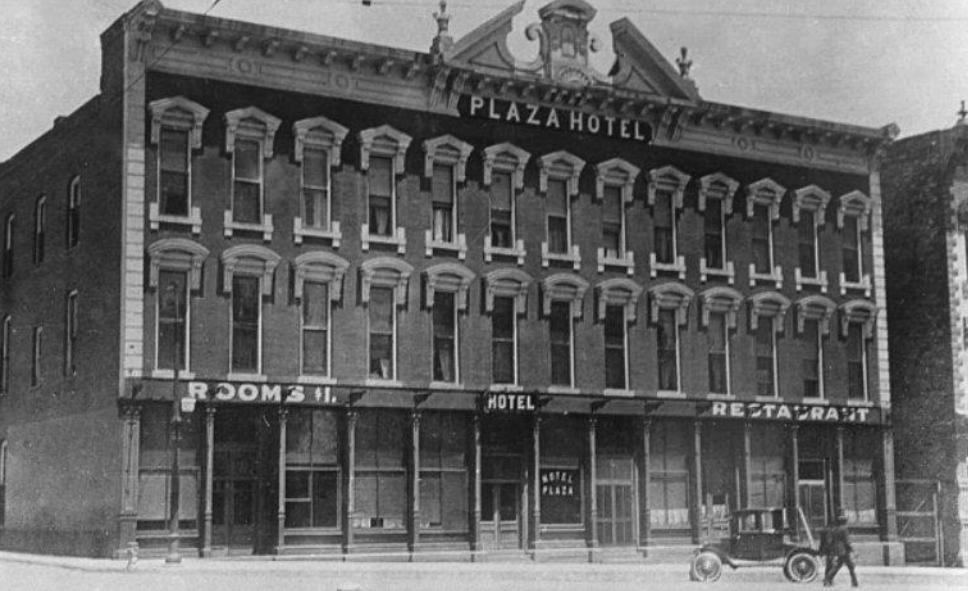In 1882, a local merchant named Don Begnino Romero and Jean Pendaries raised $25,000 to build the Plaza Hotel which was soon dubbed the “Belle of the Southwest.” However, it closed after only 4 years due to mismanagement and economic troubles in the area. With a new management team and with extensive renovations, the hotel to re-opened in 1887. The hotel became the social gathering spot for political and business organizations.
Charles llfeld, a German immigrate, purchased the adobe building from Jean Pendaries on the north side of the Plaza Hotel. His business became so successful that he soon replaced the adobe building with a more massive stone building in 1890. The new building was three stories above a basement. If you stand to face the front of the Ilfeld building today, you can see where the original building stood and where the addition was added by a vertical line of brownstone. Today the Ilfeld building encompasses the Plaza Hotels expansion.
In 1900 the Plaza Hotel closed again as a railroad strike and the depression caused local activities to seize, and it was these activities that made the Plaza Hotel famous. The era of silent films ushered in another wave of popularity to Las Vegas and the Plaza Hotel. In 1913, Romaine Fielding, the country’s most famous film star, and his Lubin Company selected Las Vegas and the Plaza Hotel for their studio headquarters. The Plaza Hotel was renamed the “Hotel Romaine” during Fielding’s five-month stay, and though considerably faded, that name can still be seen on the building’s west facade.
The Hotel’s film career did not end with the departure of Fielding. Tom Mix, the famous cowboy, actor, and director enjoyed the hospitality of the renan1ed Plaza Hotel while taking full advantage of the remaining vestiges of the Old Wild West. Many scenes from the highly popular Tom Mix movies were filmed in and around Las Vegas incorporating shots of the Plaza Hotel in several episodes.
In 1944 Byron T. Mills discussed the history of the hotel for a newspaper article for the Las Vegas Daily Optic after the recent sale of the property.
“Byron T. Mills today announced the sale of the Historic Plaza Hotel, located on the northwest corner of the Old Town Plaza, to Johnny Ortiz, owner of the El Ortiz Club. The Plaza Hotel is built on the site of the Old Las Vegas hotel, which is believed to have been the first hotel in Las Vegas and was an operation before 1846. Only 18 years after the United States extended its military occupation to New Mexico in 1846, a deed dated April 2, 1864, conveyed the building then known as “Las Vegas Hotel,” from John Dold to John Pendaries.
From the fact that it was known as “Las Vegas Hotel” historians believe that it was the first and foremost hotel in the Las Vegas area, add as such was an important station on the flourishing Santa Fe Trail. Hundreds of freight trains and caravans once stopped on the Plaza to discharge freight and passengers and for rest, U.S. mint and bartering.
Notorious evil men of the West once made their headquarters on the Old Town Plaza. Billy the Kid was at one time held in the County Jail located on Valencia Street just back of the Plaza Hotel but was later moved to the southern part of the territory for trial after a threatened “mob hanging.” Bob Ford and Dick little, members of the Jesse James Gang, operated a saloon on Bridge Street a few steps from the plaza in 1884 and 1885 after Ford killed James. Kit Carson, the Indian Scout, Governor Lew Wallace, author of “Ben Hur” we’re also frequent visitors on the Plaza during those days.
During the “eighties” and “nineties” the Plaza Hotel was home of the cattle kings and sheep baron’s of the West, and most of the celebrities from neighboring states were guests there while in Las Vegas. Although the present building replaces the original two-story edifice which was the “Las Vegas Hotel,” it antedates the arrival of the booming sheep and cattle days of the eighties. The Old Las Vegas hotel was razed the present family hotel without bar or billiard room was erected ” according to the most approved lines of that period” by the Las Vegas Hotel and Improvement Company, a number of
businessmen and firms, ” to accommodate the increasing demands of the public with a first-class modern hotel,” according to Mr. Mills.”
The popularity of the Plaza Hotel declined until the 1960’s. The resurgence focused on Mrs. Lucy Lopez, better known as “Mama Lucy,” a local entrepreneur with a considerable interest in northern New Mexican politics. The Plaza Hotel and its coffee shop became the hotbed of political organizations planning and change through the early 1970’s.
In February 1981 Lonnie and Dana Lucero formed a partnership with Katherine Slick and the renovations to return the Plaza Hotel to its former splendor began. After 13 months and two million dollars, the Plaza Hotel reopened on December 31st, 1982. In 1882, it had 54 rooms, but in 1982, after it was renovated, the number of rooms was reduced to 37 to add private baths and generous dressing rooms. With the expansion of the Ilfeld building, the Plaza Hotel now has 72 rooms, the Ilfeld Ballroom, meeting salons, an exercise facility and an underground “Rathskellar.” The hotel has an in-house restaurant, the Landmark Grill, and Byron T’s Saloon. The hotel is listed on the State Register of Cultural Properties and is part of the Las Vegas Plaza Historic District. The Plaza Hotel has also been named on the National Register of Historic Places.

